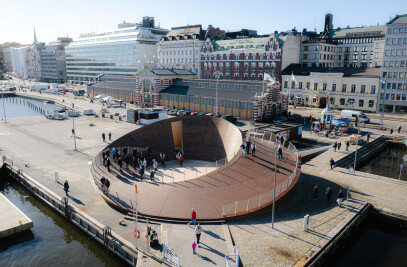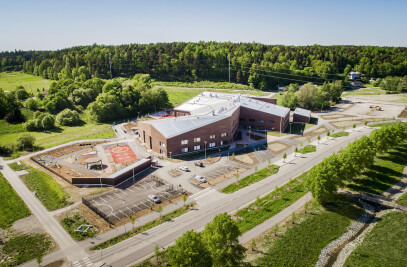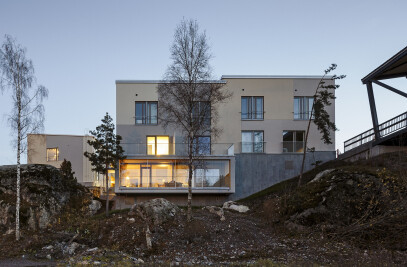Pedagogical model as a starting point In the “Future School” educational activities will increasingly take place outside the traditionalclassroom and introduce new ways of learning. Saunalahti school is a building tailored to support thepedagogical ideas of a forward-looking school. In its operation, the school puts special emphasis onnew ways of learning, art and physical education and collaboration. The building supports these ideasby creating places for interaction of various scales and atmospheres.
”Learning by doing” Learning and doing with ones own hands improves learning results. Art and physical educationversatilely contribute to good learning and growth. In Saunalahti school these teaching spaces havebeen dedicated a prime location in the building. The workshops open through glass walls to the streetand the school yard.
"Out of the classroom" The spatial organization of Saunalahti school supports learning also outside of the classrooms andencourages kids to use the school spaces in open-minded and unorthodox ways. Every interior andexterior space is a potential place for learning.
"Interaction and collaboration" In addition to classes 1 to 9 of the comprehensive school, Saunalahti school houses a day care centre,preschool, youth house offering leisure activities and a small library combining the functions ofcommunal and school library. In evenings and weekends different operators organize clubs andactivities bringing together different user groups. The gymnastics premises are in communal use andthe local residents actively use the sport fields and play grounds of the school yards. The building withits versatile array of services becomes the meeting point for the families in the area.
Common building for the whole community Saunalahti school is a multi-purpose building for education and culture. The school is closely linked tothe future central square of the new residential area of Saunalahti and its open character makes it anactive part of the everyday environment of the residents.
The building is set on the site in a way that makes the school yards as safe and as comfortable aspossible. On the west side the building borders the street while on the southern and eastern sides themain spaces openly connect to the square and the future residential area through the school yards.The building forms a sheltering background to the school yards, protecting them from the traffic andnoise of the street. Main entrances are from both the street and the yard side. The home areas havetheir own entrances from the yard.
The school yards are divided by the building into areas with favourable conditions for children ofdifferent ages. The youngest children with shorter school days enjoy sunlight in the morning andmidday hours on their cosy yard. The older kids part of the yard is more closely connected to thesquare and continues receiving sunlight over the lower workshop wing until late in the afternoon. Thetwo sports fields and the equipment for exercise and play scattered around the school yards are usednot only during the school days but also by the locals on evenings and weekends.
The topography of the site has been utilized in the terraced yard which winds around the front of thedining hall forming an outdoor theatre. The theatre integrates the interior and exterior worlds into asingle spatial whole. The theatre stage is situated at the joint between the school yards for the olderand younger children.
Functionality of the building The functions and spaces are organized like a city into public, semi-public and private areasdepending on the activity and the age of the children.
The most public space and the space where all different user groups meet is the multi-purpose dininghall - the heart of the building. The stage opens to the dining hall which also serves as the festival hallof the school. The auditorium and the small library combining the functions of communal and schoollibrary are situated next to the heart space and the main entrance. The heart space and its stairs andbalconies provide views over the outdoor auditorium and beyond to the central square of Saunalahtiarea, somewhat like a Greek theatre set into the mountainous landscape. The spatial organization ofthe building and the stimulating school yard encourage children to go outside during the breaks to playand move around.
Classrooms for the smaller children are organized into home areas with their own separate small scalelobbies with views to the school yards. The lobbies are used for group work and are closely connectedboth to the classrooms and to the heart space. The day care centre on the ground floor has its ownyard on the quietest corner of the site. The older children's classrooms and the administration areplaced to the second floor around the heart space.The spaces for art and physical education comprise the workshop area between the street and theschool yards. The spaces including workshops for cooking, music, wood, metal and textile handicraftsreveal the action to the surroundings through large openings to the street and the student work gallerytoward the school yard. The youth house is placed to the southernmost part of the building next to theworkshops and the future central square, providing it with a distinct atmosphere suitable for the leisureactivities. The gymnastics halls on the ground floor can be used separately from the rest of thebuilding through the entrances on the northern side.
Façades and materials The scale of the building varies according to the functions and the age of the children both in thefaçades and inside the building. The free-from shape of the new school building follows the terrain.The roof, undulating to provide the optimal sun light conditions for the school yards, takes the shape ofa soft meandering landscape. From the central square and the neighbouring apartment buildings thecopper roof forms the fifth façade of the building.The vast light central heart space of the building is emphasized by the characteristic free-form ceilingthat echoes the form of the roof. Massive walls of cast on site concrete support the laminated timberbeams that are left visible on the eaves outside the large glass wall of the space. Energy-efficientsolutions – such as efficient heat recovery ventilation, highly controlled lighting and solar power – areused in the building.
Authentic materials used both on the façades and in the interiors are durable and give the building awarm and relaxed atmosphere – rough red brick, warm wood, concrete and copper on the façadesand oak, concrete and light coloured rough surfaced brick in the interiors.Subtle colours are used in the interiors in combination with the real colours of the surface materials togive the spaces warm and peaceful atmosphere suitable for learning. Brighter colours are usedsparingly. The staircases and other spaces for circulation of different parts of the building have theirunique signal colours. The colour scape of the furniture and signs of these areas echo the colours ofthe to help orientation in the large building.
The brick façades utilize the versatile properties of brick, comprising a collage of different brick-layingand bonding techniques. The layered belts of different brick bondings create an intermediate scale tothe façade of the large building and emphasize the undulating eave line of the walls. The woodenfaçades facing the school yards are sheltered by long eaves.

































